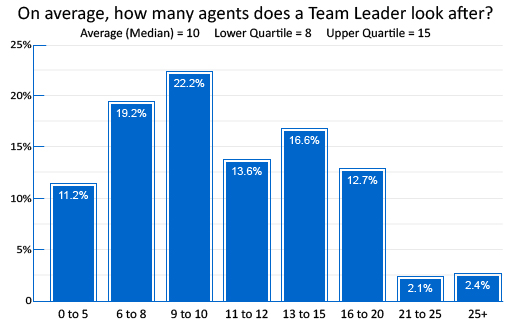When it comes to optimising performance in the contact centre, one question consistently sparks debate: what’s the ideal team leader to agent ratio? Striking the right balance is critical – too few agents per leader may underutilise resources, while too many can overwhelm even the most capable supervisors.
It’s relatively common to aim for a ratio somewhere between 8 and 15 agents per team leader. It’s a helpful guideline, but with nearly double the number of agents at the upper end of that spectrum, this broad range leaves room for interpretation.
So, how do you determine the sweet spot that aligns with your team’s needs and organizational goals? In this article by Megan Jones we explore the best team leader to agent ratio in the contact centre, outlining the pros and cons of different ratios to help you find the one that works for you.
3 Considerations to Determine the Best Team Leaders to Agent Ratio
1. Would 1:13 Ratio Work For You?
According to Elizabeth Murphy, Sales Centre Manager at AllClear Insurance Services – with over 15 years’ experience in the business – a team leader to agent ratio of 1:13 offers the perfect balance, and here’s why:
Avoid Overloading Team Leaders with a 1:15 Ratio
Experience shows that a 1:13 team leader-to-agent ratio is often the sweet spot for effective management.
“Over the years, I’ve found that the 1:13 ratio really works across the floor. I’ve tried pushing it up to 1:15 in the past, and every time it’s put incredible pressure on the team leaders involved, leaving them overwhelmed by their responsibilities.”
The reasoning is clear – more agents mean more work for team leaders. From coaching sessions and return-to-work interviews to 1-to-1 meetings, the demands grow quickly as team sizes increase. Exceeding the manageable threshold can lead to burnout and reduced efficiency.
1:8 for Newly Trained Team Leaders
Smaller ratios can be an excellent strategy for easing new team leaders into their role. As Elizabeth Murphy explains: “While I find that a 1:13 ratio works best across the contact centre floor, I currently have two teams with a ratio of 1:8 to help new team leaders settle into their responsibilities and gain confidence.”
By starting with a more manageable team size, newly trained leaders can focus on mastering the essentials of their role, such as coaching, performance management, and communication, without feeling overwhelmed. This gradual approach sets them up for long-term success.
Anything Less Than 1:13 Can Leave Team Leaders Underutilised
“A ratio below 1:13 often means team leaders struggle to fill their weeks with meaningful work. It’s a fine balance, but 1:13 has proven to be the sweet spot.”
Coaching and Team Performance Suffers Above 1:13
It’s not just about team leader stress. When the ratio exceeds 1:13, 1-to-1s and coaching sessions often shrink from 45 minutes to a rushed 20 minutes.
This may cover key stats and performance updates, but it cuts short meaningful discussions to address performance gaps or potential issues. Over time, this can significantly impact team success.
For tips and advice on how you can develop your team leaders, read our article: Train Team Leaders Well
2. Every Contact Centre Is Different
Whilst Elizabeth’s experience and insight certainly provides a more solid answer than the 1:8–1:15 ratios, it won’t necessarily work for everyone.

If you aren’t convinced 1:13 is for you, here are some other considerations to weigh up when deciding what’s right for your contact centre.
Less Can Be More
When team leaders are tasked with escalations, general support, or additional responsibilities, a lower team leader-to-agent ratio can be highly beneficial. Smaller teams creates stronger relationships, better communication, and more personalised support.
In close-knit teams, leaders can stay attuned to their agents’ lives – whether it’s knowing about their children, pets, or daily challenges. This personal connection is easier to maintain in smaller teams, whether working side-by-side on the contact centre floor or virtually through team huddles.
Smaller teams also reduce competition for the leader’s attention, enabling more meaningful interactions. Agents benefit from regular coaching, 1-to-1s, and support, all of which improve engagement and morale.
Team Leaders Have More Focus and Balance in Their Role Too
It’s not just about agents’ well-being either. The benefits of lower ratios extend to team leaders too. Sadly, some team leaders are stretched far too thinly in their roles – especially when they have larger teams to look after and have other tasks they are expected to complete too.
This is where smaller teams can make a big difference, as fewer people to manage makes for more meaningful interactions, tailored coaching sessions, and more, as well as better job satisfaction, and less stress (and churn) in the long run.
For more on how team leaders can better manage their time, read our article: How to Effectively Manage a Team Leader’s Time
3. A Higher Ratio Can Work Well
Despite these benefits, circumstance sometimes requires higher ratios, and some situations lend themselves more to this being a success.
Here are some key questions to ask yourself before you scale up:
Are Your Agents Able to Work Autonomously?
Success with a higher team leader to agent ratio is often driven by agents being able to work autonomously.
For example, if the role is relatively straightforward and the team is experienced, then there will be less need for a hands-on team leader – compared to a scenario where the role is varied and complex and there are lots of new starters, and a seasoned team leader is constantly in demand.
Top Tip:
If you are under-resourced, you may find it is easier to create a bigger team of experienced agents with a higher team leader to agent ratio in place, and then move some of your less experienced agents into smaller teams with a lower team leader to agent ratio to cater to individual needs whilst still maximizing your resources.
Do You Have Well-Defined Escalation Processes and Support Resources in Place?
One of the key areas where team leaders step in is to help support their teams deal with less common queries or to pick up a customer complaint call. These are more suited to a more experienced agent.
However, team leaders can be spared a lot of this work if their teams are equipped with easy-to-navigate information to help them handle all manner of queries AND if there is a dedicated complaints team to route any unhappy customers through to.
If these tasks are being absorbed elsewhere in the contact centre, team leaders will have more time to coach and support a larger team – without compromising on the quality of support individual agents receive.
Is Your Team Leader Experienced Enough to Manage a Bigger Team?
Training, leadership experience and personality types in your team leaders can also have an impact on how big or small your ratios need to be, and you may find it varies from team leader to team leader.
In most cases, a larger team leader to agent ratio can be supported well by a more experienced team leader, who is well equipped to:
- inspire confidence in their team
- delegate responsibilities to empower agents
- set out clear expectations and escalation processes from the offset
This allows agents to work well without draining their team leader’s time. By contrast, a less experienced team leader could unintentionally create a culture of dependence and inefficient working practices.
For team leader skills and where a good team leader should focus their time, read our article: Team Leadership: What Makes a Great Leader?
Still Not Sure What’s Right for Your Contact Centre?
Why not do your own experiment? Of course, you don’t want to shake things up and risk upsetting everyone, as that might negatively skew the results.
Why not add your next new starter into a team of 14 (taking it up to 15) or see what happens if you don’t rush to boost your team of 10 back to full strength the next time someone hands in their notice?
Over time, you’ll get a good sense of how things are going – particularly if you take the time to regularly talk to your team leaders and their teams about their experiences. You might even come to realize that 1:13 is the magic ratio after all.
For more great insights on staffing and team leadership, read our articles:
- How to Work Out How Many Staff You Need in a Contact Centre
- 9 Traits of High-Performing Team Leaders
- How to Prepare Agents for Team Leader Roles
Author: Megan Jones
Reviewed by: Hannah Swankie
Published On: 8th Dec 2021 - Last modified: 8th Jan 2026
Read more about - Call Centre Management, Editor's Picks, Management Strategies, Staffing, Team Building, Team Management






































